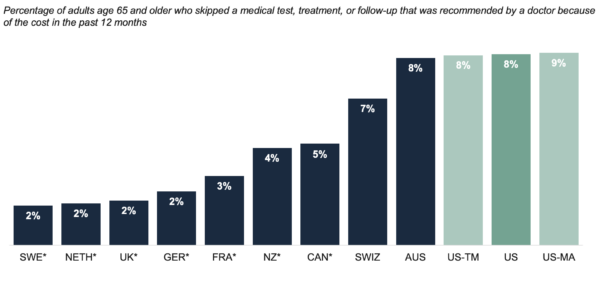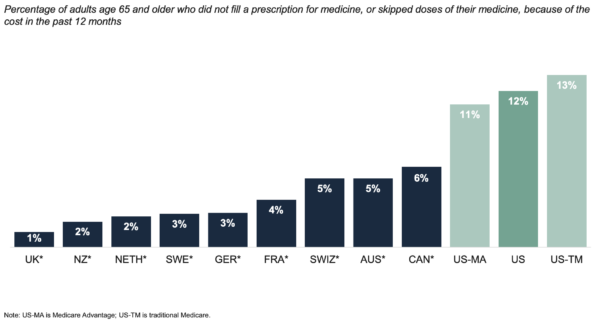US Seniors Experience Worst Cost Barriers to Care
The Commonwealth Fund just published a ten-nation survey of health care affordability for seniors. Guess who had the highest financial barriers to care? Yup, the US. Medicare helps (beats being young & uninsured or having massive deductibles), but needs lower cost-sharing.
December 4, 2024
Health Care Affordability for Older Adults: How the U.S. Compares to Other Countries
Commonwealth Fund
By Munira Z. Gunja et al.
December 4, 202
Like several other countries, nearly all adults age 65 and older in the U.S. have health coverage. But high out-of-pocket costs in the Medicare program may still make it more difficult for older Americans to receive affordable care compared to older adults in other countries.


Comment by: Jim Kahn
I just spent 3 days in Amsterdam, the Netherlands. Everyone seemed quite content. No wonder, given the extremely low prevalence of medical care cost barriers observed in this survey. Similar for most other nations included. The U.S. performs worst overall, by far, and worst or 2nd worst on each measure. I’m beginning to think that uncertainty in the US on medical care affordability is a major underlying cause of stress, anxiety, and the drive for political upheaval (more on that in a future post).
Now I’m in Nairobi, Kenya, at a meeting about addressing dementia in low-income countries. These nations face huge challenges not only for treatment and care, but also for prevention programming. Because … they have very little money. We in the high-income nations need to do a lot more to help them, and they should more emphatically prioritize heath in their budgets.
The U.S. doesn’t have the excuse of being poor. We have plenty of money – the most in the world. Our problem is that we build our massive health care system (fully 40% of global health spending) to benefit for-profit intermediaries and providers. This drives up costs. And insurance coverage is designed on the flawed premise of “skin-in-the-game” (empirically, it does not control costs). Lots of pain, no real gain.
Best practices, learning from successful approaches, following the leaders … whatever phrase you prefer, it’s long past due for the US to adopt proven practices from peer nations – to assure access while controlling costs.
About the Commentator, Jim Kahn
Jim (James G.) Kahn, MD, MPH (editor) is an Emeritus Professor of Health Policy, Epidemiology, and Global Health at the University of California, San Francisco. His work focuses on the cost and effectiveness of prevention and treatment interventions in low and middle income countries, and on single payer economics in the U.S. He has studied, advocated, and educated on single payer since the 1994 campaign for Prop 186 in California, including two years as chair of Physicians for a National Health Program California.
See All PostsYou might also be interested in...
Recent and Related Posts
Laying out the Ill-Effects of Medicaid Cuts in the Congressional Budget Bill
